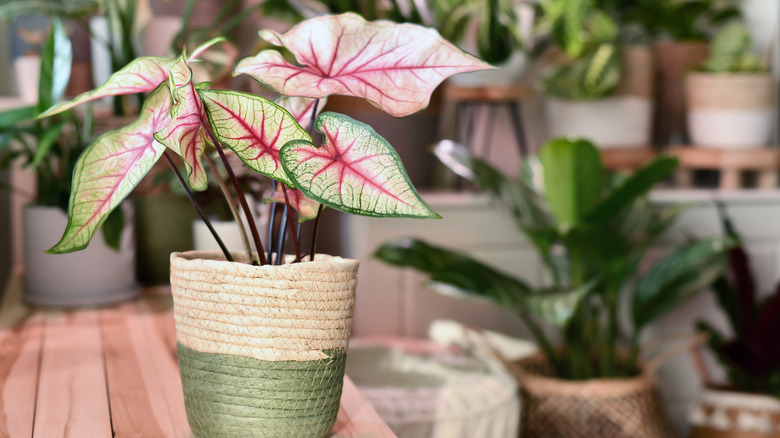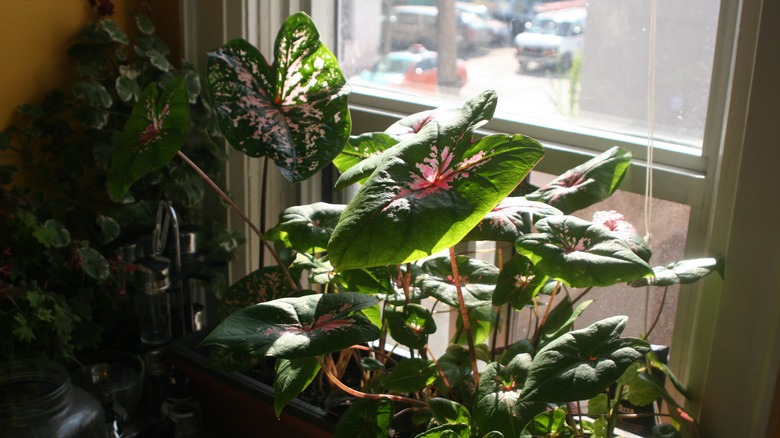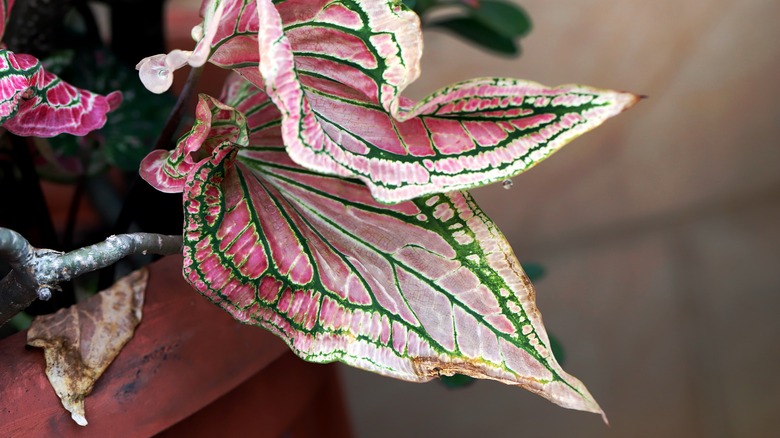Crucial Things To Consider Before Growing Caladiums As An Indoor Houseplant
Caladium, also known as the Heart of Jesus plant, has become popular with gardeners for its striking foliage. Its heart-shaped leaves are intricately patterned in shades of white, pink, and green. Caladium does produce flowers, but gardeners typically cut them off to allow the plant to focus its energy on its spectacular leaves, which provide color in garden borders, as ground cover, and as filler between other plants. But this outdoor plant can also thrive indoors, making it an easy way to bring nature into your home — as long as you know how to care for it. If you provide your caladium with the light and water it needs and understand its unusual life cycle, this plant will brighten your home for years to come.
Caladium is a tropical plant originating in South and Central America. Outdoors, it's hardy in USDA zones 8 to 10, though it's often grown as an annual in colder climates. It typically grows to a height of one to two feet. Because caladium loves shade, it's an excellent choice for gardeners trying to fill shady patches or for plant parents whose homes don't get much light. Here's how to keep your caladium houseplant happy indoors.
The right light and water
Caladiums love shade, which can make it easier to keep them happy indoors. They still need sunlight to photosynthesize, but they prefer indirect light. Indirect light hits a plant after reflecting off a surface or being filtered through a medium (like window glass), making it weaker than direct sunlight. Most indoor light is indirect, but the strength varies. A window blocked by a leafy tree will provide less light than an unobstructed window. South-facing windows provide more light than north-facing (if you live in the northern hemisphere). Since caladium likes plenty of shade, it's a prime candidate for small, obstructed, or north-facing windows. If your window provides brighter light, you can weaken it by hanging a sheer curtain or moving the plant up to a few feet away from the window.
Since caladiums are tropical plants, they need plenty of moisture. During warmer months, when your caladium is in its active growth stage, water at least once per week. Wait until the surface of the soil is dry before watering again, but don't let the soil fully dry out between waterings. Caladium also appreciates humidity. If you live in a dry climate, keep your plant in a bathroom or near a humidifier if possible. If that's not an option, misting it often will help keep it happy. Although caladiums love moisture, they are prone to waterlogged soil. Planting your caladium in a pot with a drainage hole will provide extra protection from accidental overwatering.
The life cycle of caladium
Before adopting a caladium into your home, it's important to understand this plant's somewhat unorthodox life cycle. Caladium is a tuber plant, meaning its vegetation grows from a bulb hidden in the ground. In its natural habitat, caladium goes dormant in the winter, when its foliage dies back but its bulb survives. Even indoors, in a controlled-temperature environment, caladium will usually go dormant after a few months of active growth. So if your plant's once-vibrant greenery suddenly droops and withers, don't be alarmed. Cut the vegetation back to soil level, stop watering, and wait for the plant to resume active growth.
Temperature swings can cause caladium to go dormant prematurely. To avoid this, keep your houseplant a safe distance from any source of drafts, like air vents or doors. When the temperature drops in winter, you may need to move your plant farther from the window to prevent it from getting a chill.
Caladium's love of shade makes it a perfect houseplant for growing indoors — as long as you keep a few things in mind. Give your caladium houseplant the right amount of water (lots) and the right amount of sun (a little), and replicate the warm, humid environment that it's used to. Also understand the life cycle of a caladium and that it needs a period of dormancy. Leave it alone every winter after its leaves die back, and this beautiful plant will be ready to brighten up your home again in the spring.


